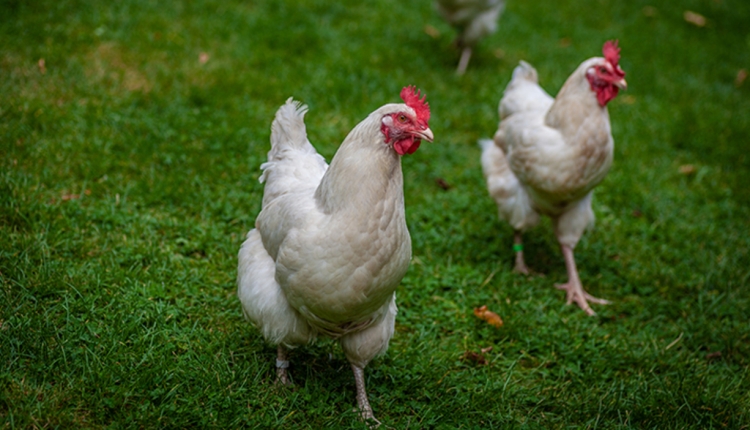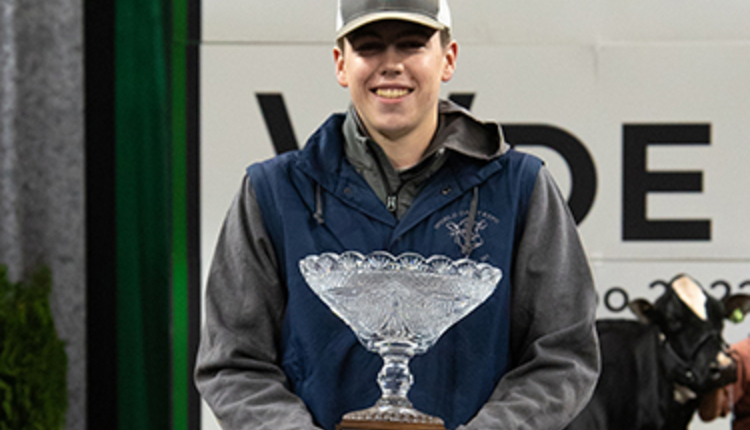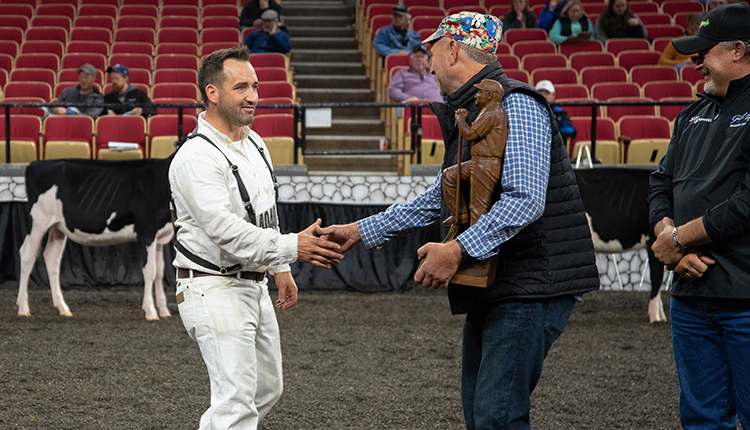"Let me put your back tag on," said the reassuring but firm voice from what I would quantify as a "man's man."
That firm, steady, reassuring voice caused me to flash back about 30 years ago to one of my very first dairy showmanship competitions. Thirty years ago, that voice was my dad, but the more recent statement came from Ukrainian born Vadim Gazda, who fastened competitor number 309 onto my back. Like dairy showmanship and judging competitions, that "back tag," known as a competitor number in dance circles, would serve as my identification to judges, ring personnel, and spectators alike throughout the event. Unlike dairy competitions, 309 would be the only number throughout the event as I was the entry . . . there would be no cow at the end of my lead strap.
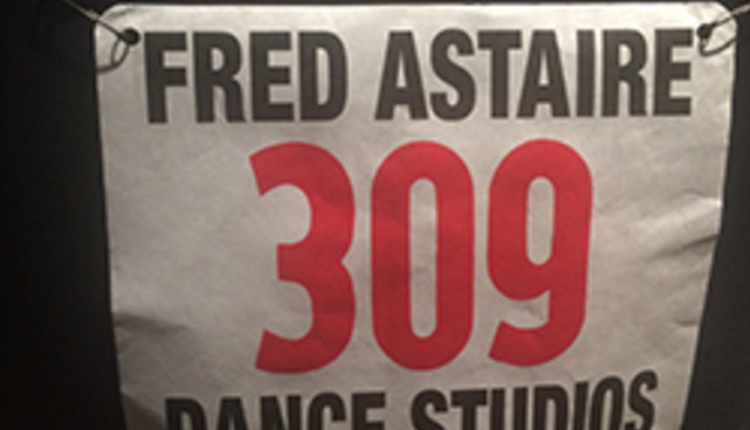
Having attached the back tag to my black shirt, Vadim made one more check by kneeling on the floor and lifting up one of my pant legs and said, "Good. Black socks. We are set, where are the ladies?" he then asked.
Before we talk ladies, let's talk about those black socks.
While it's customary to wear lily white when showing dairy cattle, midnight black is generally the color of choice for Latin (rumba, cha-cha, and swing) and Smooth (waltz, foxtrot, and so forth) competitions. There is good reason for this custom. In cattle shows, one really doesn't notice the talented exhibitor because the cow that this leadsman shows off captures the judge's and audience's eye as that beautiful bovine glides across the shavings.
The same is true in dance. While male dancers lead the dance, it's the ladies who get to perform the fun spins, elegant moves, and wear razzle-dazzle dresses. Yes, dance competitions are really about the ladies just as cattle shows are about the cows. (Editor's note: Those in the dance community may be alarmed that I am comparing women to cows, please know that this may be the highest compliment in dairy circles . . . so we will continue onward.)
So where were the ladies?
Think about that hour or so before the star cow enters the ring. It's clipping chute time for the beautiful bovines being prepped for the graceful walk across World Dairy Expo's colored shavings. The same is true for the darlings of the dance show - the ladies.
In the makeup and dressing room you can find many talented people preparing hair, adding hair extensions, attaching eyelashes, and applying makeup. After all, it takes a lot of color to carry through the bright lights on a dance floor one-third the size of the Coliseum's showring floor.
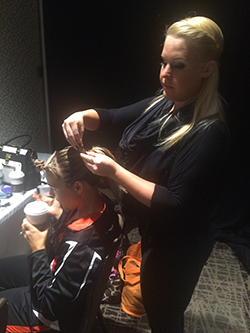 The preparation area is a flurry of activity. My wife, Krista Knigge, a dairy farm girl, was among those dancing darlings. Catey Rice, our very first dance instructor when we began this journey four years back, was primping Krista. It was like watching the legendary Duncan MacKenzie himself getting his favorite cow from the pack ready for the big day. Even more memorable for Duncan, I mean Catey, she had carefully instructed Krista and I since the very first dance lesson. It was like watching a newborn calf transform into a contender for Intermediate or Grand Champion honors at World Dairy Expo. That being the case, it was challenging to see who was more excited about the occasion, Catey or Krista.
The preparation area is a flurry of activity. My wife, Krista Knigge, a dairy farm girl, was among those dancing darlings. Catey Rice, our very first dance instructor when we began this journey four years back, was primping Krista. It was like watching the legendary Duncan MacKenzie himself getting his favorite cow from the pack ready for the big day. Even more memorable for Duncan, I mean Catey, she had carefully instructed Krista and I since the very first dance lesson. It was like watching a newborn calf transform into a contender for Intermediate or Grand Champion honors at World Dairy Expo. That being the case, it was challenging to see who was more excited about the occasion, Catey or Krista.
Smiles were wide and no effort was spared. Catey was the Duncan MacKenzie of the hour and armed with 10 Junior American Smooth and Rhythm Championships; Krista had an equally qualified mentor and "fitter" in Catey.
In the showring, I mean dance floor, the activity looked quite similar before the dairy show.
Sound and lighting checks were taking place. A crew was spot washing the floor from prior competitions. Videographers and photographers were making last-minute system checks. After all, just like World Dairy Expo, this Fred Astaire Cross Country Dance Competition was going to be broadcast on the World Wide Web.
The five-day national dance competition had its divisions, just like the dairy breed shows. Replacing Ayrshires, Brown Swiss, and Guernseys were American Rhythm, American Smooth, International Standard, and International Rhythm.
For Krista and I, we were dancing in the American Rhythm section with cha-cha, rumba, and East Coast Swing being heifer, young cow, and older cow classes. We added a splash of West Coast Swing to our competition, sort of like bringing the neighbor's good Milking Shorthorns along to the show.
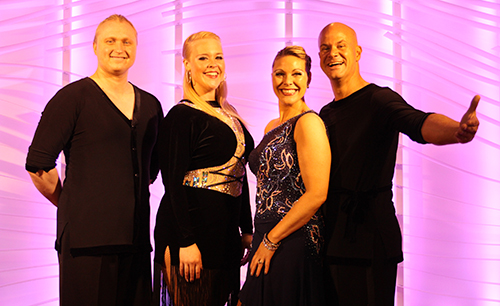
In the second portion of this blog, we will unveil show time. For dairy folks that would involve actually stepping into the ring. For now, we leave you with an image of Vadim Gazda and Catey Rice, shown to the left, with Krista and yours truly on the right.

The author is the managing editor, and he brings 19 years of industry leadership to our readers overseeing all editorial content and production of the magazine. His degree from the University of Wisconsin-Madison combined dairy science and agricultural economics.
That firm, steady, reassuring voice caused me to flash back about 30 years ago to one of my very first dairy showmanship competitions. Thirty years ago, that voice was my dad, but the more recent statement came from Ukrainian born Vadim Gazda, who fastened competitor number 309 onto my back. Like dairy showmanship and judging competitions, that "back tag," known as a competitor number in dance circles, would serve as my identification to judges, ring personnel, and spectators alike throughout the event. Unlike dairy competitions, 309 would be the only number throughout the event as I was the entry . . . there would be no cow at the end of my lead strap.

Now that 309 number looked a little different than most numbers. First, it was in red ink. That told everyone that I was an amateur male. So did the fact that the number started with a 300 series number. That 309, red color back tag was just like putting shirts on junior entries at a dairy show. It set me apart as all the professional males wore black-numbered back tags with 100 series tags.
Hearing Vadim's voice was rather reassuring for me. While a competitive person by nature, this was my first trip across the national dance stage. I knew having Vadim, one of my instructors, in my corner was a big deal. For those in the dairy world it would be like having a Klussendorf or Duncan MacKenzie winner from cattle showing fame as my mentor throughout the day, as Vadim had competed three times at England's Blackpool dance competition. And three times, Vadim had won the invitation-only dance competition at ages 9, 13, and 17. It would be like Vadim claiming Supreme Champion of World Dairy Expo's Junior division on three different occasions. To say the least, this wasn't Vadim's first dance across the stage.Having attached the back tag to my black shirt, Vadim made one more check by kneeling on the floor and lifting up one of my pant legs and said, "Good. Black socks. We are set, where are the ladies?" he then asked.
Before we talk ladies, let's talk about those black socks.
While it's customary to wear lily white when showing dairy cattle, midnight black is generally the color of choice for Latin (rumba, cha-cha, and swing) and Smooth (waltz, foxtrot, and so forth) competitions. There is good reason for this custom. In cattle shows, one really doesn't notice the talented exhibitor because the cow that this leadsman shows off captures the judge's and audience's eye as that beautiful bovine glides across the shavings.
The same is true in dance. While male dancers lead the dance, it's the ladies who get to perform the fun spins, elegant moves, and wear razzle-dazzle dresses. Yes, dance competitions are really about the ladies just as cattle shows are about the cows. (Editor's note: Those in the dance community may be alarmed that I am comparing women to cows, please know that this may be the highest compliment in dairy circles . . . so we will continue onward.)
So where were the ladies?
Think about that hour or so before the star cow enters the ring. It's clipping chute time for the beautiful bovines being prepped for the graceful walk across World Dairy Expo's colored shavings. The same is true for the darlings of the dance show - the ladies.
In the makeup and dressing room you can find many talented people preparing hair, adding hair extensions, attaching eyelashes, and applying makeup. After all, it takes a lot of color to carry through the bright lights on a dance floor one-third the size of the Coliseum's showring floor.

Smiles were wide and no effort was spared. Catey was the Duncan MacKenzie of the hour and armed with 10 Junior American Smooth and Rhythm Championships; Krista had an equally qualified mentor and "fitter" in Catey.
In the showring, I mean dance floor, the activity looked quite similar before the dairy show.
Sound and lighting checks were taking place. A crew was spot washing the floor from prior competitions. Videographers and photographers were making last-minute system checks. After all, just like World Dairy Expo, this Fred Astaire Cross Country Dance Competition was going to be broadcast on the World Wide Web.
The five-day national dance competition had its divisions, just like the dairy breed shows. Replacing Ayrshires, Brown Swiss, and Guernseys were American Rhythm, American Smooth, International Standard, and International Rhythm.
For Krista and I, we were dancing in the American Rhythm section with cha-cha, rumba, and East Coast Swing being heifer, young cow, and older cow classes. We added a splash of West Coast Swing to our competition, sort of like bringing the neighbor's good Milking Shorthorns along to the show.

In the second portion of this blog, we will unveil show time. For dairy folks that would involve actually stepping into the ring. For now, we leave you with an image of Vadim Gazda and Catey Rice, shown to the left, with Krista and yours truly on the right.

The author is the managing editor, and he brings 19 years of industry leadership to our readers overseeing all editorial content and production of the magazine. His degree from the University of Wisconsin-Madison combined dairy science and agricultural economics.







